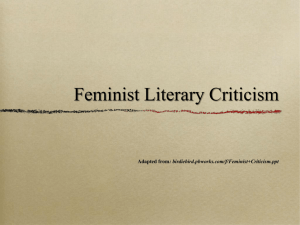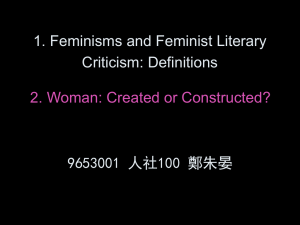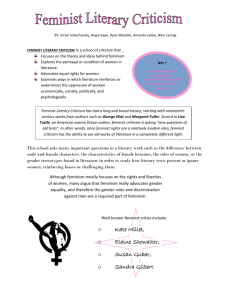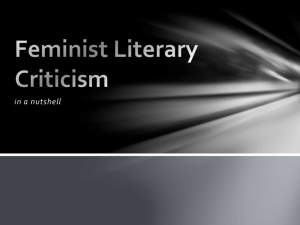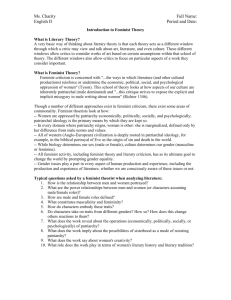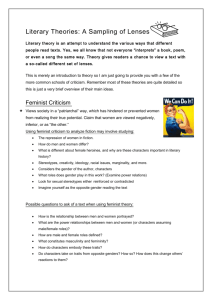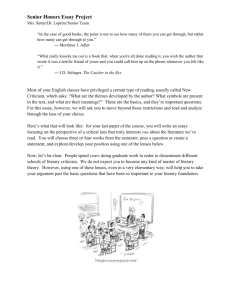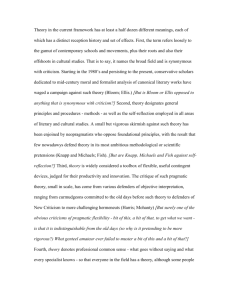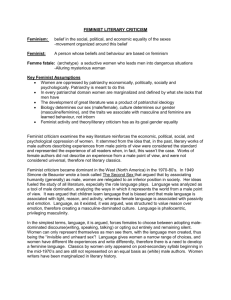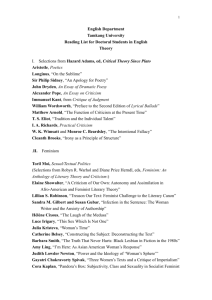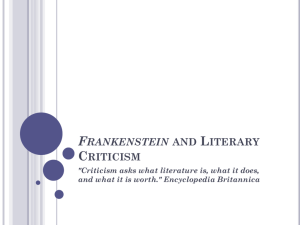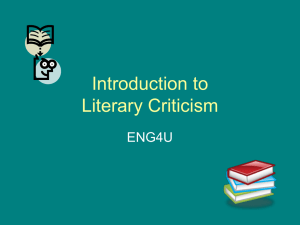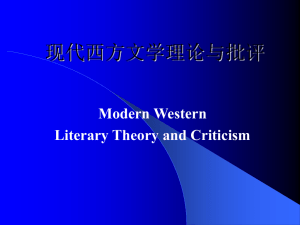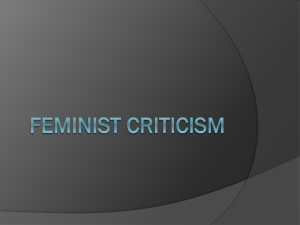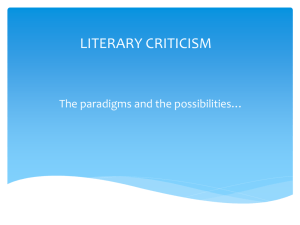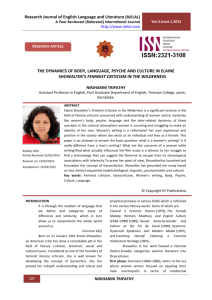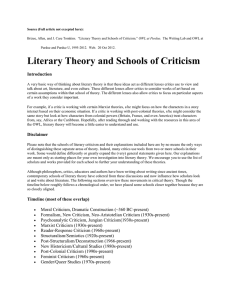Document
advertisement
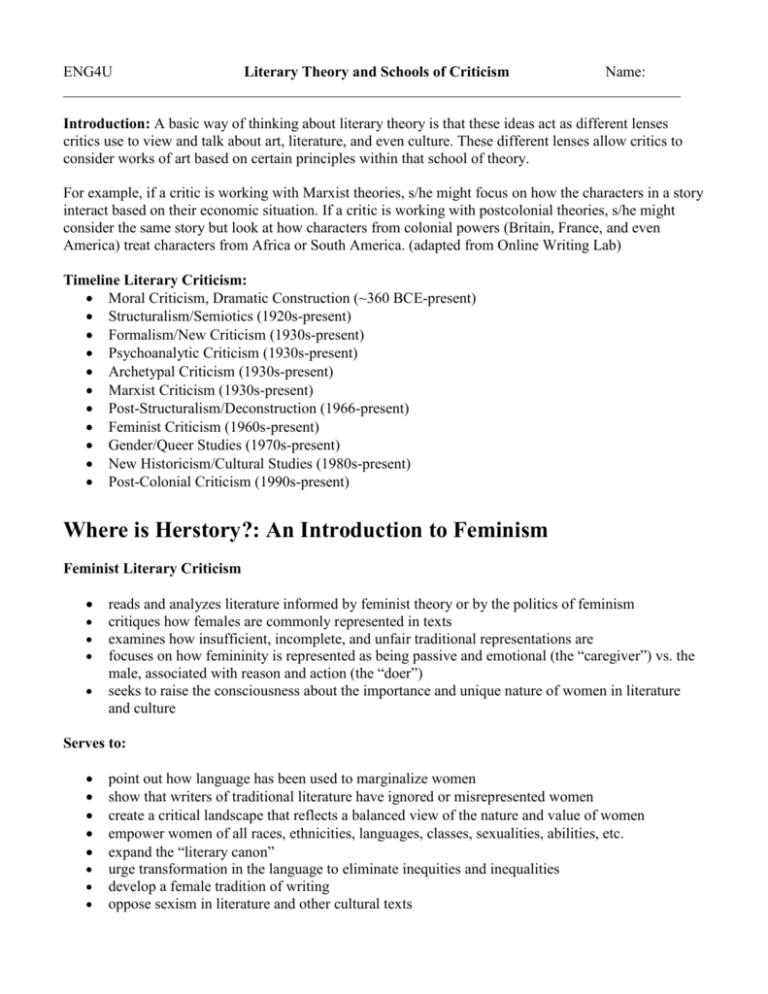
ENG4U Literary Theory and Schools of Criticism Name: __________________________________________________________________________________ Introduction: A basic way of thinking about literary theory is that these ideas act as different lenses critics use to view and talk about art, literature, and even culture. These different lenses allow critics to consider works of art based on certain principles within that school of theory. For example, if a critic is working with Marxist theories, s/he might focus on how the characters in a story interact based on their economic situation. If a critic is working with postcolonial theories, s/he might consider the same story but look at how characters from colonial powers (Britain, France, and even America) treat characters from Africa or South America. (adapted from Online Writing Lab) Timeline Literary Criticism: Moral Criticism, Dramatic Construction (~360 BCE-present) Structuralism/Semiotics (1920s-present) Formalism/New Criticism (1930s-present) Psychoanalytic Criticism (1930s-present) Archetypal Criticism (1930s-present) Marxist Criticism (1930s-present) Post-Structuralism/Deconstruction (1966-present) Feminist Criticism (1960s-present) Gender/Queer Studies (1970s-present) New Historicism/Cultural Studies (1980s-present) Post-Colonial Criticism (1990s-present) Where is Herstory?: An Introduction to Feminism Feminist Literary Criticism reads and analyzes literature informed by feminist theory or by the politics of feminism critiques how females are commonly represented in texts examines how insufficient, incomplete, and unfair traditional representations are focuses on how femininity is represented as being passive and emotional (the “caregiver”) vs. the male, associated with reason and action (the “doer”) seeks to raise the consciousness about the importance and unique nature of women in literature and culture Serves to: point out how language has been used to marginalize women show that writers of traditional literature have ignored or misrepresented women create a critical landscape that reflects a balanced view of the nature and value of women empower women of all races, ethnicities, languages, classes, sexualities, abilities, etc. expand the “literary canon” urge transformation in the language to eliminate inequities and inequalities develop a female tradition of writing oppose sexism in literature and other cultural texts Feminist Theory Terminology: Binary thinking: the inability to see “grey areas” between seemingly opposing categories Cultural construction: the notion that gender behaviour isn’t natural, biological or innate; it is a creation Intersectionality: the ways in which various constructed categories (gender, race, ability, class, etc.) interact to manifest themselves as inequality in our society Male privilege: the unearned privileges that men receive as a result of living in a patriarchal society Misogyny: fear or hatred of women Objectification: defining one by her/his sexual attributes and ignoring the rest of his/her existence “Other”: the marginalization of a group or individual which allows those with power to define themselves against those who are “different” Patriarchy: a society or social system that is controlled primarily by men or in which men have a disproportionate amount of power Performance: the notion that we learn and enact binary gender roles based on socialization and cultural construction Male Female Active Passive Dominating Acquiescent Adventurous Timid Rational Emotional Creative Conventional Phallocentrism: privileging of the masculine or defining the male as the center Sexism: prejudice or action based on sex, especially discrimination against women “The gaze”: asserting dominance by staring at, objectifying, and sexualizing those one considers inferior to or merely of use to oneself Re-occurring Images of Women in Literature: Angel Madonna Saint Muse Eve Pandora Witch Castrating Mother Madwoman Questions a Feminist Theorist would Ask Does the text reflect or resist a dominant gender ideology? Does it do both? Does the main character in a narrative affirm or resist gender roles? What happens to female characters who rebel against strict gender roles? Whose story gets told in the text? Are female characters ignored or devalued? Are male characters hyper-masculine? Are values that support the patriarchy given privilege? This can happen tacitly, in the way in which values are taken to be self-evident. Feminist theorists would also study the use of language in a text because many feminists believe that much of the language we use is “masculine.” Are there sex-role stereotypes, or does the author write to turn stereotypes upside-down? Who has power? Who is the hero? Who has all the lines? Are there gender stereotypes? Are “female” qualities/stories valued or criticized or absent? Are female figures infantilized (treated like children) in the text? How much personal freedom do women have in the text? What does the text suggest about women’s place in society? Christina Rossetti, “In an Artist’s Studio” One face looks out from all his canvasses, One selfsame figure sits or walks or leans; We found her hidden just behind those screens, That mirror gave back all her loveliness. A queen in opal or in ruby dress, A nameless girl in freshest summer greens, A saint, an angel; – every canvass means The same one meaning, neither more nor less. He feeds upon her face by day and night, And she with true kind eyes looks back on him Fair as the moon and joyful as the light; Not wan with waiting, not with sorrow dim; Not as she is, but was when hope shone bright; Not as she is, but as she fills his dream.
